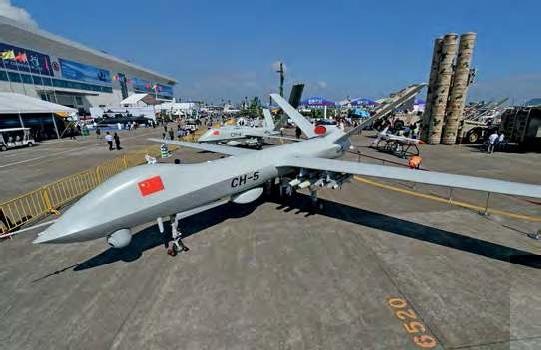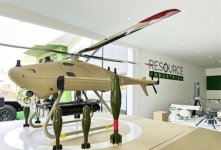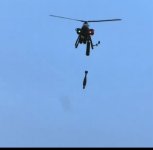BLOOMING CHINESE DRONES
- Aviation Features
- Blooming Chinese drones
24th January 2019
FEATURE
There are numerous Chinese medium-altitude long-endurance UAVs now in service or development, as Piotr Butowski tells us
Debuting at Airshow China 2018 was the Wing Loong I-D version, which features 70% composite construction, a wider wingspan and a more powerful engine than earlier Wing Loong variants. This aircraft flew on December 23, 2018.
All photos Piotr Butowski
IN THE January issue of AIR International, we reported on the new Chinese high-speed all-wing unmanned combat air vehicle designs and futuristic drones, displayed at Airshow China in Zhuhai in November 2018.
Less daring, but moneygenerating, Chinese UAVs in the medium-altitude long-endurance class were also on show. Most of these replicate the classic layout of American General Atomics Predator.
Pterodactyls for export
A few weeks after Airshow China, on December 25, 2018, the Aviation Industry Corporation of China (AVIC) ceremonially unveiled the 100th Wing Loong I intended for export. It is not known who is going to receive the milestone aircraft.
Wing Loong I systems have been sold to the United Arab Emirates (starting in 2011), Saudi Arabia, Kazakhstan, Pakistan, Egypt, Indonesia and Uzbekistan. Saudi examples saw combat in Yemen, while Iraq has used the system during the campaign against the Islamic State group.
The Wing Loong, or Pterodactyl, is the export name of the Yilong (Winged Dragon) system developed by Chengdu Aircraft Design and Research Institute (CADI), a part of the state-owned AVIC. The prototype of the initial and the most widespread Wing Loong I version flew in October 2007. The type has entered service with the People’s Liberation Army Aviation Force designated the GJ-1 (Gongji, meaning attack).
When presenting the 100th export drone, Li Yidong, who has headed Chengdu’s UAS programmes since 2010, told Chinese TV that, apart from the 100 Wing Loongs already produced, “we still have 100 more orders to be fulfilled”.
According to CAI, the Wing Loong I’s endurance is 20 hours. The aircraft’s service ceiling is 22,966ft, maximum speed is 151kts (280km/h) and its take-offweight 1,200kg (2,646lb), including 275kg (606lb) of fuel and a 200kg (441lb) weapons payload.
Specifications given by one of the operators, Kazakhstan, differ from those of the manufacturer, with the operator quoting take-offweight as 1,100kg (2,425lb) and service ceiling as 16,404ft.
The Wing Loong I has a 14m-long (45ft 11in) straight wing and 9.05m-long (29ft 7in) fuselage, V-shaped tail and turbocharged 100hp (74kW) Rotax 914 piston engine with pushing propeller.
Typical for UAVs of this class is an electro-optical payload with an infrared camera, TV camera and laser target designator mounted under the nose. The ordnance is carried on two underwing hardpoints.
Debuting at Airshow China 2018 was the Wing Loong I-D version (presented two years earlier in the form of a small model). With a take-offweight of 1,500kg (3,307lb) it is a vehicle of virtually the same class as the first of the Pterodactyls, but it has several significant improvements. Seventy percent of the airframe’s weight is composite, the aerodynamics have been improved, the wingspan lengthened to 17.6m (57ft 9in) and a more powerful diesel engine installed.
All these features enable the I-D version to carry 400kg (882lb) of ordnance on four underwing pylons and remain airborne for 35 hours. The Wing Loong I-D’s maiden flight took place on December 23, 2018, lasting 30 minutes.
Wing Loong II in service
The largest drone of the Wing Loong family is the Wing Loong II. Approximate in size to the MQ-9 Reaper system, a Wing Loong II was presented on the static display at Zhuhai in two locations, in the AVIC section and People’s Liberation Army Air Force section.
Only the latter aircraft (number 53130) was a debut, for the first time displayed in the colours of the People’s Liberation Army Aviation Force and with the military designation GJ-2. The production version for People’s Liberation Army Aviation Force has no large winglets, a characteristic of the vehicles presented previously.
The jet-powered CADI Yunying (Cloud Shadow) has a ceiling of 44,291ft and speed 320kts.
The Wing Loong II has a take-offweight of 4,200kg (9,259lb), three times heavier than the previous versions. It carries 480kg (1,058lb) of payload and can remain airborne for 20 hours at an altitude of up to 29,528ft. It is powered by an AEP50E turboprop engine of Chinese production, rated at 500hp (368kW). The maiden flight of the prototype took place on February 27, 2017.
The Wing Loong II is actively advertised by AVIC and has been displayed at several international air shows, including Le Bourget in June 2017, Dubai in November 2017 and Singapore in February 2018. Reported export customers for the Wing Loong II are the United Arab Emirates and Egypt. Licence production of 48 drones is expected to be launched by Pakistan.
Li Yidong said two years ago that the Wing Loong II had received a large foreign order, “the largest in [the] history of Chinese UAVs”. Media in Saudi Arabia claim it was the delivery of 300 systems for the nation. However, in March 2017, King Abdulaziz City for Science and Technology signed an agreement with another Chinese company, the China Aerospace Science and Technology Corporation (CASC), to open an assembly facility in Saudi Arabia for CASC’s competing CH-4 Caihong (Rainbow) system. These reports are dificult to interpret.
Apart from the Wing Loong series, CADI also presented the Yunying (Cloud Shadow) drone at Zhuhai. This is of similar purpose and weight class to the Wing Loong, but is powered by a turbojet engine. The advantages of the jet engine are high flight altitude (up to 44,291ft) and speed (320kts/620km/h). The penalty for that performance is shorter endurance: six hours with a 200kg (441lb) payload or five hours with 400kg (882lb) payload.
The Cloud Shadow is not new; it was displayed at Zhuhai two years ago and abroad in Dubai in November 2017. The vehicle has been flying since May 16, 2016, but nothing has been heard about its production or orders.
Another jet-powered drone made its debut at Zhuhai: the reconnaissance-combat WJ-700 presented by China Aerospace Science and Industry Corporation (CASIC). The WJ-700 has a take-offweight of 3,500kg (7,716lb) and endurance of 20 hours; other data was not disclosed.
Rainbow series
Airshow China also saw CASC present already-known drones from the Caihong (Rainbow) series: the CH-4 with a 1,330kg (2,932lb) take-offweight and 30 hours’ endurance, and the CH-5 with 3,000kg (6,614lb) take-offweight and 40 hours’ endurance. The CH-4 is an equivalent of the Wing Loong I and the CH-5 an equivalent of the Wing Loong II.
Making its debut at Zhuhai was the China Aerospace Science and Industry Corporation WJ-700 reconnaissance-combat system.
The CH-5 was presented with four AR-1B and four smaller AR-2 missiles. The smaller CH-4 is in the background.
The HK-5000G armed reconnaissance UAV is intended for operation from ships and is therefore equipped with a folding wing.
The only novelty in the display of the CH-4 and CH-5 at Zhuhai was new ventral pods with electronic equipment and new weapons. The smaller CH-4 appeared with four AR-1 and AR-1A guided missiles and the larger CH-5 with four AR-1B and four smaller AR-2 missiles.
None of these Rainbow drones has entered service in China; instead, the CH-4 has become one of the best-selling UAVs on the international market. Starting in 2015, the CH-4, including the armed CH-4B version, was purchased by Algeria, Egypt, Iraq, Jordan, Saudi Arabia and the United Arab Emirates. Apparently, most buyers of Chinese UAV systems are Middle East countries, which for several reasons do not want or were denied purchase of the world’s most popular US or Israeli systems.
Tengden for military and commercial users
Sichuan-based Tengden together with Poly Technologies, which debuted in Zhuhai with a huge transport drone TW356 (see AIR International, January 2019), also presented some smaller combat reconnaissance UAVs in a twinboom configuration with two turboprop engines, similar to the Israeli Heron.
The TW328 (or TB) vehicle was fitted with four pylons for weapons or reconnaissance pods. Among possible loading options, CM-502KG, C-701K and FT-9 missiles were presented, as well as two types of the guided bombs. The TW328 has a 20m (65ft 7in) wingspan and 2,800kg (6,173lb) take-offweight. It can remain airborne for up to 45 hours at an altitude of up to 26,247ft and speed of up to 151kts (280km/h).
Nearby, there was the same system in a civil version named Scorpion, designed to transport freight using underwing containers. An initial version of the system demonstrated its freight delivery capability by dropping supplies in late 2017.
Airborne early warning drone
The JY-300 Tianshao (Sky Whistle) presented in the China Electronics Technology Group Corporation (CETC) booth is an airborne early warning radar integrated into a conventional drone not dissimilar to the shape of the General Atomics Predator.
The JY-300 has been developed by the 38th Research Institute of CETC. A characteristic feature is the integration of the sensors into the airframe structure, including conformal active electronic scanned array radar aerials at the leading and trailing edges of the wing (which was not visible on the displayed mock-up) and along the sides of the forward fuselage. The JY-300 made its first 30-minute flight at Shaanxi Pucheng airport in October 2018.
Shipborne drone
The Aeromarine Intelligent Equipment Company, a subdivision of China Shipbuilding Industry Corporation, demonstrated a mock-up of its HK-5000G armed reconnaissance UAV. This system is intended for operation from ships and is therefore equipped with a folding wing.
The design is at a very early stage and the data given by the company representative during the show, a take-offweight of 5,000kg (11,023lb) and endurance of 12 hours, is liable to change. Given the drone’s weight and its moderate-thrust engine, the UAV will have to use a catapult. Only China’s third aircraft carrier will use an electromagnetic catapult; the present two carriers use a ski jump take-off.
Although not visible on the mock-up, the China Electronics Technology Group Corporation JY-300 Tianshao (Sky Whistle) is designed to have sensors, including conformal active electronic scanned array radar, integrated into the airframe














 Tian Ying (Credit: JR Ng)
Tian Ying (Credit: JR Ng)














